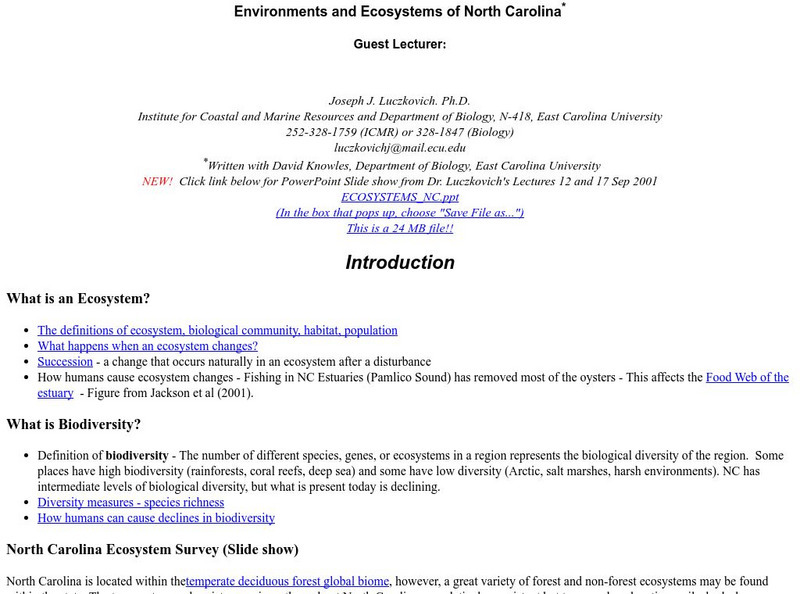Hi, what do you want to do?
Curated OER
My Wet Robot
Students design an underwater vehicle. In this engineering lesson, students will design an underwater robot that includes specific systems for it to function properly. Each group will present their prototype to the class.
Curated OER
Yummy Plant Parts
Young scholars examine plant parts. In this botany lesson plan, students examine various edible plants and how their adaptations help them to grow. They observe stems, leaves, roots and flowers of plants and discuss the relationship...
Curated OER
Modeling Estuaries
Students create a model estuary. In this modeling estuaries lesson, students identify characteristics and mix water of varying densities. Students form a hypothesis, conduct an experiment, and analyze the results.
Curated OER
Connecticut Wildlife: Biodiversity and Conservation Status of Our Vertebrate Populations
Young scholars explore the different types of vertebrates found in their area. In this environmental science lesson plan, students perform a case study on the Common Raven. They analyze data collected from research and create charts and...
Curated OER
Explorit's Wetlands Quiz
In this wetlands worksheet, students complete a 31 question multiple choice on-line interactive quiz about marshes and wetlands.
Curated OER
Explorit's Wetlands Quiz
In this wetlands instructional activity, students complete a 31 question multiple choice on-line interactive quiz about wetlands. Included are questions about plants, animals and geography.
Curated OER
Algae Experiments
Learners describe the characteristics of algae. In this biology instructional activity, students perform a series of experiment to explore algae. They investigate the basic things algae need to survive.
Curated OER
Earth Pockets
Students identify the Earth's natural resources. In this Earth science lesson, students read the book The Great Kapok Tree and discuss types of natural resources. Students use categories such as wood, paper, and trees and list items that...
Curated OER
Wise Use of Our Resources
In this resource review worksheet, middle schoolers will review the definition of key vocabulary words and then fill in the blank with the correct term in 10 sentences.
Curated OER
Duck
In this ducks worksheet, students read information paragraphs about the habitat, reproduction, feeding and adaptation of ducks. Students study the photograph of the bird. There are no questions to answer here.
Curated OER
Salt Marsh Plants and Animals
In this salt march plant and animals activity, students read descriptions of animals, then match each to its picture. Students then read about tidal animals and choose which animals in picture are most likely to be in a salt march at low...
Curated OER
Art/Ocean Scene
Students draw and color an ocean scene based on the paintings of Wyland. In this ocean art lesson plan, students view slides of seascapes before they complete their project using oil pastels.
Curated OER
Water Quality Monitoring
Students comprehend the four parameters of water quality. They perform tests for salinity, dissolved oxygen, pH and clarity or turbidity. Students comprehend why scientists and environmental managers monitor water uality and aquatic...
Curated OER
Animal Life Histories Derived From Morphology
Students learn the mechanisms of natural selection by deducing information from the physical appearance of the animal.
Curated OER
Lotic Environment
Students assemble a classroom river model as an example of a lotic system. They control and measure biotic and abiotic information for the in-class system and compare data with a lotic system in a natural environment.
Curated OER
Lotic Environment Lesson Plans
Students create and conduct experiments on a "classroom river habitat." They manipulate the biotic and abiotic factors so that they are able to compare an artificially prepared river model to a naturally occurring lotic ecosystem.
Curated OER
Florida's Springs
Students follow the journey that water takes in aquifers and springs. They write about the major threats to the aquifer and the solutions to these threats.
Curated OER
Bermuda: Search for Deep Water Caves 2009: Out of Darkness
Young scholars analyze the three models on the origin of troglobitic fauna. In this life science lesson, students also consider how the Zonation model explains the fauna's origin. They also use the Internet to research solutional and...
World Wildlife Fund for Nature
Wwf: Our Earth: Ecoregions: Habitats: Freshwater Wetlands
An introduction and overview of freshwater wetland habitats.
A-Z Animals
A Z Animals: Reference: Habitats: Freshwater
Learn about the plants, animals, and other characteristics of some freshwater ecosystems.
Science Education Resource Center at Carleton College
Serc: Fish Habitats
During this lesson, students spend time looking at pictures of fish and their habitat, talking about what all animals need to live, making a poster of a fish habitat, and finally visiting a lake.
A-Z Animals
A Z Animals: Reference: Habitats: Swamps and Wetlands
Learn about the plants, animals, and other characteristics of some wetland ecosystems.
Other
Environments and Ecosystems of North Carolina
North Carolina is located within the temperate deciduous forest global biome, however, a great variety of forest and non-forest ecosystems may be found within the state. The temperature and moisture regimes throughout North Carolina are...
Ducksters
Ducksters: Science for Kids: Freshwater Biome
Kids learn about the freshwater aquatic biome. Ecosystems such as rivers, streams, ponds, lakes, wetlands, swamps, and bogs.




























